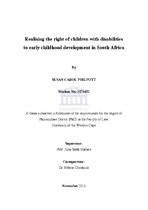| dc.description.abstract | This study sets out to establish what is required of the South African government to
comply with international human rights treaties and Constitutional obligations with
respect to early childhood development (ECD) for children with disabilities. This
requires clarification of the nature, scope and content of ECD and conceptual
frameworks for child development and childhood disability are therefore presented.
Early childhood is defined as the period from birth to four years of age. It is a period
(by comparison to any other phase in the life course) of accelerated growth, during
which brain development can be optimally promoted. It is at the same time a highly
sensitive period when permanent damage caused by toxic stress can be averted.
Early childhood is an opportunity for early intervention for children with disabilities,
and is ideally suited for promoting social inclusion between children with disabilities
and those without disabilities, particularly in early learning settings. By virtue of its
potential to promote optimal development of young disadvantaged children in
particular, ECD is not only a means of working towards equity, it has been recognised
as a national investment. The content of ECD, drawing from the most recent
publication of the South African Child Gauge (2013), is seen as comprising an
‘essential package’ of services, including nutrition, health, social services, caregiver
support and early learning opportunities.
The focus of this study is on the Convention on the Rights of the Child, the African
Charter on the Rights and Welfare of the Child and the Convention on the Rights of
Persons with Disabilities (CRPD) all of which have provisions relating to the general
context of children with disabilities as well as to the components of the ‘essential
package’. In addition to the sector-related rights contained in these treaties, they
impose general obligations on the State with respect to legislative and other measures
which it must undertake. These are discussed together with the State obligations
under the South African Constitution which provide not only for non-discrimination,
dignity and equality, but also for specific socio-economic rights for children which
create justiciable obligations for the State. Having established the obligations of the State under international law and the
Constitution, there is analysis of current legislation and policies and the extent to
which they are compliant. A brief description is given of the history of disability and
ECD-related services during the apartheid era, and how these have shaped current
provision. Attention is given to provisions of the Children’s Act for ECD, partial care
and prevention, and early intervention, where there is a lack of a clear mandate for
funding services. Further, while limited Social Security is provided to children with
disabilities in the form of Care Dependency Grants, these are likely to reinforce a
welfarist perspective unless viewed as part of a broader initiative for equalisation of
opportunities and development of children with disabilities. In respect of the right to
health, progress made in reducing maternal and child mortality rates is applauded, but
the primary focus on preventive and curative care has ‘crowded out’ a comprehensive
view of primary health care as also encompassing rehabilitative care. Further,
mechanisms to ensure early identification and intervention for children with
disabilities, through developmental screening and referral, need to be strengthened.
In respect of the right to education, there has been limited attention given to children
under the age of five years, including within the Inclusive Education Policy (White
Paper 6).
The study therefore concludes that there are various areas in which there is a lack of
alignment between the State obligations under international law, and current
legislation and policies. However, drawing on the CRPD in particular, and the current
heightened political attention being given to ECD, evidenced by its inclusion in the
National Development Plan, this study further concludes that there exists at present a
tremendous opportunity to ensure the inclusion of children with disabilities such that
they are able to enjoy all the benefits of ECD and thereby reach their full potential. | en_US |

